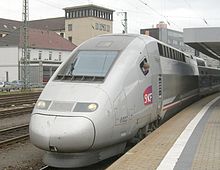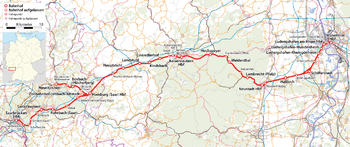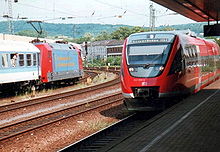- Palatine Ludwig Railway
-
Mannheim−Saarbrücken Route number: 670 Line number: 3250 (Saarbrücken–Homburg)
3280 (Homburg–Ludwigshafen)Gauge: 1435 Voltage: 15 kV, 16,7 Hz AC Maximum speed: 160 Legend
Rhine Valley Railway S 1S 2S 3S 4 from Heidelberg 
Mannheim–Stuttgart HSL 
Reid Railway from Frankfurt (Main) Hbf 
Baden Rhine Railway from Karlsruhe Hbf 
107.9 Mannheim Hbf 
Reid Railway 
106.7 Konrad Adenauer Bridge 
Baden-Württemberg/Rhineland-Palatinate state border 



Old Ludwigshafen am Rhein Hbf 



Line from Mainz 

106,4 Ludwigshafen (Rhein) Mitte 


105.2 Ludwigshafen am Rhein Hbf 
103.2 Ludwigshafen-Mundenheim 
101.4 Ludwigshafen-Rheingönheim 

99.0 Limburgerhof junction (Schifferstadt bypass) 

98.5 Limburgerhof 



94.5 Schifferstadt 

to Germersheim S 3S 4 

90.9 Böhl-Iggelheim junction (Schifferstadt bypass) 
89.7 Böhl-Iggelheim 
85.9 Haßloch 
Palatine Northern Railway to Monsheim 
78.9 Neustadt-Böbig 
Palatine Maximilian Railway 
77.2 Neustadt Hbf 
Wolfsberg Tunnel (320 m) 
70.7 Lambrecht (Pfalz) 
Cuckoo Railway to Elmstein 
68.0 Neidenfels 
Lichtensteiner-Kopf Tunnel (92 m) 
Retschbach Tunnel (196 m) 
Schönberg-Langeck Tunnel (366 m) 
Mainzer-Berg Tunnel (212 m) 
62.7 Weidenthal 
Gipp Tunnel (217 m) 
Köpfle Tunnel (158 m) 
Eisenkehl Tunnel (65 m) 
Kehre Tunnel (302 m) 
Schlossberg Tunnel (208 m) 
59.2 Frankenstein (Pfalz) 
Franzosenwoog Tunnel (79 m) 
Alsenz Valley Railway to Bingen 
54.2 Hochspeyer 
Heiligenberg Tunnel (1347 m) 
Connecting line to Enkenbach 
43.7 Kaiserslautern Hbf S 2 terminus 
Biebermühl Railway to Pirmasens 
Lauter Valley Railway to Lauterecken 
41.0 Kennelgarten 
40.2 Kaiserslautern AW 
39.0 Vogelweh 
35.7 Einsiedlerhof 
31.8 Kindsbach 
28.4 Landstuhl 
to Kusel 
22.7 Hauptstuhl 
18.6 Bruchmühlbach-Miesau 
Rhineland-Palatinate/ Saarland state border 
Glan Valley Railway to Staudernheim 
0.0 31.1 Homburg (Saar) Hbf S 1 terminus 
30.3 Blies Valley Railway 

1.0 

4.1 Altstadt (Saar) 

7.5 Bexbach (Höcherberg) 

former Bavaria-Prussia border 

9.7 Neunkirchen-Wellesweiler 

13.6 Neunkirchen (Keilbahnhof), Nahe Valley Ry, Prims Valley Ry 

29.8 

28.3 Limbach-Altstadt customs station 


26.3 Limbach (b Homburg, Saar) 
21.5 Kirkel 
Schwarzbach Valley Railway from Pirmasens 
16.0 Rohrbach (Saar) 
Schwarzbach Valley Railway junction (until 1895) 
12.5 Sankt Ingbert 
former Bavaria-Prussia border 
9.4 Rentrisch 
7.1 Scheidt (Saar) 
5.1 Schafbrücke 
3.7 Halberg junction to Saargemünd, until 1945 
2.7 Saarbrücken–Sarreguemines railway 
2.7 Saarbrücken-Ost (Keilbahnhof) 
Nahe Valley Railway from Bingen 
0.0 Saarbrücken Hbf 
Line to Trier and Line to Metz The Palatine Ludwig Railway (German: Pfälzische Ludwigsbahn) is a main line railway from Ludwigshafen am Rhein to Saarbrücken. It was opened in 1847 and 1848 and is one of the oldest railways in Germany. The section to Ludwigshafen to Homburg is now part of the network of the Rhine-Neckar S-Bahn.
An extension was opened in 1867 across the Rhine to Mannheim, which was not historically part of the Ludwig Railway, but since the building of a new Ludwigshafen Hauptbahnhof in 1969 has effectively formed part of it.
Sections of the line have been redeveloped for a maximum speed of 200 km/h for the TGV services between Paris, Stuttgart and Munich.
Contents
Route
From Ludwigshafen to Schifferstadt the line runs directly toward the southwest, it then turns right and runs in a straight line until just before Neustadt-Böbig; it then leaves the Upper Rhine Plain and begins to climb the Haardt range. From there, it has the character of a mountain railway line.
After Neustadt an der Weinstraße it passes through the Palatinate Forest, running through 12 tunnels. First, it passes through the Wolfsberg Tunnel. After Lambrecht is the branch of the Cuckoo Railway (Kuckucksbähnel), which is a preserved railway running to Elmstein. Then, the line passes through more tunnels on the way to Kaiserslautern (Lichtensteiner-Kopf, Retschbach, Schoenberg-Langeck, Mainzer Berg, Gipp, Köpfle, Eisenkehl, Kehre, Schlossberg, Franzosenwoog and Heiligenberg tunnels). In the 33.5 km long section between Neustadt and Kaiserslautern the line climbs 109 metres.
A few kilometres west of Kaiserslautern, the line leaves the Palatinate Forest behind and runs almost straight through the West Palatinate lowland moor (Westpfälzische Moorniederung) through Landstuhl to Homburg.
After Homburg the line divides into two branches: one runs as a branch over the original line of the Ludwig railway via Bexbach to Neunkirchen and the other runs through Sankt Ingbert to Saarbrücken. A junction after Homburg connects to the Blies Valley Railway.
The line then passes the former Limbach-Altstadt station, which was a customs post on the 19th century border of Bavaria and Prussia. It then crosses the Blies river, winds through the St. Ingbert-Kirkel forest to the densely populated valley of Rohrbach and continues to its finish in Saarbrücken.
History
Planning and Construction (1835-1850)
On 10 January 1838 a provisional company was formed to build a line from Rheinschanze (renamed Ludwigshafen in 1865) to Bexbach. On 30 March 1838, the Bavarian railway company of the Palatinate-Rheinschanze-Bexbach Railway (Bayerische Eisenbahngesellschaft der Pfalz-Rheinschanz-Bexbacher Bahn) was formally established. In May 1844 the company was renamed the Palatine Ludwig Railway Company (Pfälzische Ludwigsbahn-Gesellschaft).
The company was directed by Paul Camille von Denis, an important German railway pioneer. Work started at the end of March 1845. The line was intended primarily for the transport of Saarland coal from the Bexbach area (then part of Bavaria) to the port and commercial centre of Rheinschanze. It was named after the Bavarian King Ludwig I. It was also agreed that a branch line would be built from Schifferstadt to Speyer, then the capital of Bavarian Palatinate.
On 11 June 1847 the 29.33 km long section from Rheinschanze to Neustadt opened; on 1 July 1848 the Kaiserslautern–Homburg section opened and on 6 June 1849 the line was extended from Homburg to Bexbach. The Kaiserslautern–Frankenstein section was opened on 2 December 1848. The line to Bexbach via Homburg was completed on 25 August 1849 with the closing of the Neustadt–Frankenstein gap. Bexbach station is the oldest surviving railway station in the Saarland. The Homburg–Bexbach section today forms part of the Homburg–Neunkirchen line.
Further development (1850–1945)
In July 1856, the line was duplicated for its whole length between Ludwigshafen and Neunkirchen. In 1866/6, the line was extended from Schwarzenacker to St. Ingbert via Bierbach, following the opening on 7 May 1857 of the Blies Valley line from Homburg to Zweibrücken via Schwarzenacker. On 25 February 1867, the Rhine bridge between Ludwigshafen and Mannheim was opened for rail operations.
On 15 October 1879 the line was completed by the Saarbrücken Railway between St. Ingbert and Saarbrücken and a new Station was inaugurated in St. Ingbert. The new link to Saarbrücken was shorter than the line via Neunkirchen. Because of the acute danger of collapse of the Hasseler tunnel between Niederwürzbach and St. Ingbert, a new line via Rohrbach with a new station in Hassel was opened on 1 September 1895. The junction with the line from Landau to Biebermühle (now Pirmasens Nord) station, Zweibrücken and Saarbrücken (known as the South Palatinate Railway and now divided into the Schwarzbach Valley Railway and the Queich Valley Railway) was moved from St. Ingbert to Rohrbach.
A further shortening of the Ludwig Railway occurred on 1 January 1904 with the opening of the new line from Homburg to Rohrbach, now a suburb of St. Ingbert.
On 1 January 1909 the Palatinate Railway became part of the Bavarian State Railways. After World War I, the Saar Basin was administrated by the League of Nations. As a result, in 1920 the Homburg–Saarbrücken section came under the administration of the Saar Railways. The rest of the line became part of the German State Railways. With the inclusion of the Saarland in the German Reich in 1935, the Saarland part of the line was taken over by the German State Railways Company.
Developments since 1945
After World War II the line between Homburg Saarbrücken returned to the administration of the Saar as part of the Railways of the Saarland (Eisenbahnen des Saarlandes, EdS). The section east of Homburg became part of the German Federal Railways (Deutsche Bundesbahn, DB). EdS was taken over by DB in 1957, following the inclusion of the Saarland in the Federal Republic of Germany.
Since the route had always been of great importance for long distance traffic, it was electrified in 1960.[1] On 8 March 1960 the line could be run electrically between Saarbrücken and Homburg. The Homburg–Kaiserslautern section followed on 18 May 1961 and by 12 March 1964 the Palatine Ludwig Railway was electrified throughout.[2] The electrification of the last section was delayed mainly because of the many tunnels between Kaiserslautern and Neustadt that had to be widened for it.[2] The operation of trains was facilitated in May 1969 by the opening of the new Ludwigshafen Hauptbahnhof, which replaced the old terminus.
In December 2003, Rhine-Neckar S-Bahn trains began running between Kaiserslautern and Ludwigshafen. S-Bahn services were extended in 2006 to Homburg. With the introduction of S-Bahn operations the stations along the route were also upgraded and the platforms were raised to a height of 76 centimetres to provide level access to the class 425 railcars. The length of platforms between Ludwigshafen and Kaiserslautern was generally extended to 210 metres (140 metres at Neidenfels) and 140 metres west of Kaiserslautern. The former Weidenthal station was abandoned and a new station was built 800 metres closer to Frankenstein.
Development plans
 POS train in Saarbrücken Hbf
POS train in Saarbrücken Hbf
On 22 May 1992 the transport ministers of Germany and France agreed on the upgrading of the route from Paris to Eastern France to Southern Germany for high-speed trains (marketed as POS trains, standing for Paris-Ostfrankreich-Süddeutschland).[3]
In May 1998, the Federal Government and Deutsche Bahn (German Railways) signed a financial agreement on the improvement of the line between Mannheim and Saarbrücken at a cost of the 351.4 million Deutsche Bahn for completion by 2004.[4] In a first stage the track was upgraded for a top speed of 160 km/h for tilting trains. The infrastructure in the sections between St. Ingbert and Kirkel and between Neustadt an der Weinstrasse and Ludwigshafen was upgraded for 200 km/h and a bypass was built around Schifferstadt. The whole Kirkel–Kaiserslautern section can now be operated at 200 km/h. The clearance of the line for 160 km/h required ETCS Level 2 signaling, control and train protection be operational by the end of 2008, although this was delayed. ETCS operations are now controlled remotely from the Karlsruhe operations centre.[5] The route through the Palatinate Forest between Neustadt and Kaiserslautern, including its many tunnels, remains unchanged structurally.
Operations
S-Bahn train in Neustadt station
Rhine-Neckar S-Bahn services (S1 and S2) operate from Ludwigshafen to Kaiserslautern every half-hour, with line S1 continuing hourly to Homburg. Regionalbahn (RB) trains to and from Kusel run between Landstuhl and Kaiserslautern. RB trains run every hour between Homburg and Saarbrücken and over the Saar Railway to Merzig and Trier. In addition Regional-Express (RE) run hourly between Kaiserslautern and Saarbrücken. Most trains are electric multiple units of class 425 or 426. Intercity-Express (ICE) trains run between Frankfurt, Saarbrücken and Paris and Intercity and ICE trains to and from Frankfurt, Stuttgart and Munich. Two peak hour RE trains run between Mannheim and Saarbrücken.
Sources
Notes
- ^ Holzborn, p. 88
- ^ a b Holzborn, p. 89
- ^ "TGV-Anbindung ausgebremst" (in German). Eisenbahn-Revue International (1): 4. 2000. ISSN 1421-2811.
- ^ "Ausbau der POS" (in German). Eisenbahn-Revue International (11): 451. 1998. ISSN 1421-2811.
- ^ "ETCS für ICE-Strecken" (in German). Signal + Draht (1+2): 45. 2007.
References
- Mühl, Albert (1982) (in German). Die Pfalzbahn. Geschichte, Betrieb und Fahrzeuge der Pfälzischen Eisenbahnen (The Palatinate Railway. History, operations and rollingstock of the Palatine railways). Stuttgart: Theiss Verlag. ISBN 3-8062-0301-6.
- Wenzel, Hansjürgen (1976) (in German). Die Südwestdeutschen Eisenbahnen in der französischen Zonen (The southwest German railways in the French zones). Wuppertal: Eisenbahn-Kurier e. V..
- Holzborn, Klaus D. (1993) (in German). Eisenbahn-Reviere Pfalz (Palatinate railway district). Berlin: transpress. ISBN 3-344-70790-6.
- Räntzsch, Andreas M. (1997) (in German). Die Eisenbahn in der Pfalz. Dokumentation ihrer Entstehung und Entwicklung (The railways in the Palatinate. Documentation of their origin and development). Aalen: Verlag Wolfgang Bleiweis. ISBN 3-928786-61-X.
- Sturm, Heinz (2005) (in German). Die pfälzischen Eisenbahnen (The Palatine railways). pro MESSAGE. ISBN 3-934845-26-6.
Bavarian State Railways Bavarian railway lines: Bavarian Ludwig Railway • Bavarian Maximilian’s Railway • Ludwig South-North Railway • Ludwig's Western Railway
Bavarian railway companies: Royal Bavarian State Railways • Bavarian Ostbahn • Munich-Augsburg Railway CompanyPalatine railway lines: Palatine Ludwig Railway • Palatine Maximilian Railway • Palatine Northern RailwayPalatine railway companies: Palatinate Railway • Palatine Ludwig Railway Company • Palatine Maximilian Railway Company • Palatine Northern Railway Company • Neustadt-Dürkheim Railway CompanyCategories:- Railway lines in Rhineland-Palatinate
- Railway lines in the Saarland
Wikimedia Foundation. 2010.





